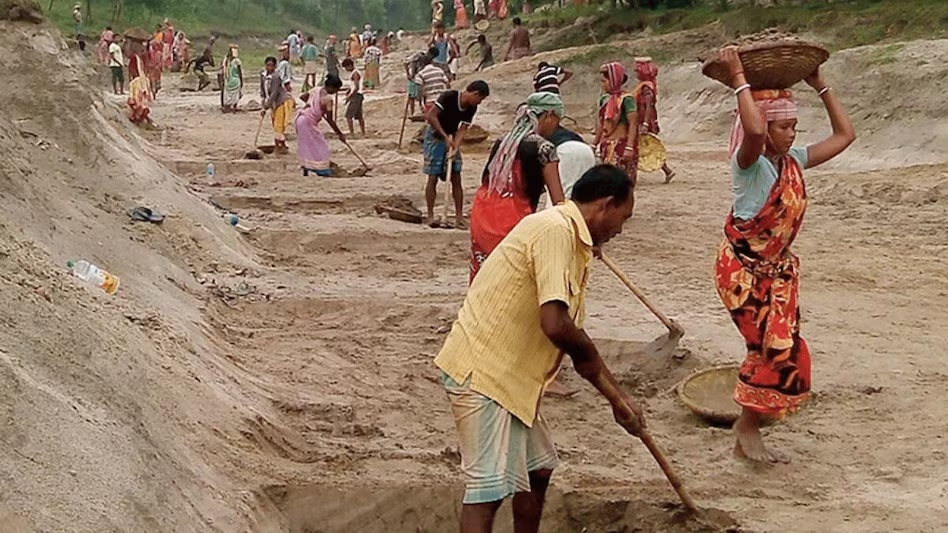Description
_ACT_AND_THE_NORTH-EASTERN_COUNCIL_ACT1.png)
Copyright infringement not intended
Picture Courtesy: www.telegraphindia.com
Context: The North-Eastern Areas (Reorganisation) Act and the North-Eastern Council Act, both enacted on December 30, 1971, played a pivotal role in officially recognizing and naming Northeast India as a distinct administrative entity. Before this, the region was often governed as a frontier province, with diverse territories falling under the umbrella of Assam.
Key Points
- The North-Eastern Areas (Reorganisation) Act and the North-Eastern Council Act were passed on December 30, 1971. These laws marked the emergence of Northeast India as a significant administrative concept, replacing the previous unit of Assam.
- Officially, Northeast India comprises eight states: Arunachal Pradesh, Assam, Manipur, Meghalaya, Mizoram, Nagaland, Sikkim, and Tripura. The North-Eastern Council, a statutory advisory body, plays a role in development planning and regional policy making.
_ACT_AND_THE_NORTH-EASTERN_COUNCIL_ACT_11.png)
The North-Eastern Areas (Reorganisation) Act and the North-Eastern Council Act
- The North-Eastern region of India comprises eight states: Assam, Arunachal Pradesh, Manipur, Meghalaya, Mizoram, Nagaland, Sikkim and Tripura. These states share a common history, culture and geography, but also have their own distinct identities and aspirations. The region has witnessed various movements for autonomy and statehood since the independence of India, as well as armed conflicts and insurgencies.
- To address the political and administrative challenges of the region, the Parliament of India enacted two important laws in 1971: The North-Eastern Areas (Reorganisation) Act and the North-Eastern Council Act. These laws aimed to reorganise the existing state of Assam into smaller states and union territories and to establish a regional council for coordination and cooperation among the northeastern states.

The North-Eastern Areas (Reorganisation) Act, 1971
The North-Eastern Areas (Reorganisation) Act 1971 was passed on 30 December 1971 and came into force on 21 January 1972. The act provided for the following changes in the territorial and political structure of the region:
- The establishment of the states of Manipur and Tripura from the existing union territories of Manipur and Tripura.
- The formation of the state of Meghalaya from the autonomous districts of Khasi, Jaintia and Garo Hills within Assam.
- The formation of the union territory of Mizoram from the Mizo district within Assam.
- The formation of the union territory of Arunachal Pradesh from the North-East Frontier Agency within Assam.
- The amendment of the First Schedule to the Constitution of India to reflect these changes.
- The allocation of seats in the Council of States (Rajya Sabha) and the House of the People (Lok Sabha) for the new states and union territories.
- The delimitation of constituencies for parliamentary and assembly elections in the new states and union territories.
- The amendment of the Scheduled Castes Order and the Scheduled Tribes Order to include or exclude certain communities in the new states and union territories.
- The provision for a provisional legislative assembly for Meghalaya until a regular assembly is constituted.
- The establishment of a common high court for Assam, Nagaland, Meghalaya, Manipur and Tripura.
|
The act was a major step towards fulfilling the demands of various ethnic groups for greater autonomy and recognition. It also aimed to reduce the administrative burden on Assam, which was facing severe problems due to insurgency and migration.
|
The North-Eastern Council Act 1971
The North-Eastern Council Act, 1971 provided for the setting up of a council for the north-eastern areas of India to be called the North-Eastern Council. The objectives of the council were:
- To secure balanced development of all sectors in all parts of north-eastern areas.
- To formulate a unified and coordinated regional plan.
- To review the implementation of projects.
- To advise on matters relating to inter-state transport.
- To discuss matters relating to common interest or concern.
- To make recommendations on any matter referred by any state or union territory in northeastern areas or by any ministry or department of the Government of India.
|
The council has the power to make rules for regulating its procedure and conduct of business. The council is an advisory body that facilitates consultation and cooperation among the northeastern states. It also acts as a forum for resolving inter-state disputes and promoting regional integration.
|
Significance
The North-Eastern Areas (Reorganisation) Act and the North-Eastern Council Act are significant legislations that have shaped the political and administrative landscape of north-eastern India. They have contributed to:
- The recognition and empowerment of various ethnic groups in terms of their identity, culture and aspirations.
- The decentralization and devolution of power from Assam to smaller states and union territories.
- The promotion of peace and stability in a region marred by violence and conflict.
- The enhancement of regional cooperation and coordination in matters of common interest or concern.
- The facilitation of balanced and inclusive development of all sectors and regions.
Steps taken to implement and improve the provisions of the two acts
- The establishment of separate high courts for Meghalaya, Manipur and Tripura in 2013 by amending the North-Eastern Areas (Reorganisation) Act, 1971.
- The upgradation of Mizoram and Arunachal Pradesh from union territories to states in 1986 and 1987 respectively by passing the State of Mizoram Act, 1986 and the State of Arunachal Pradesh Act, 1986.
- The inclusion of Sikkim as a member of the North-Eastern Council in 2002 by amending the North-Eastern Council Act 1971.
- The allocation of additional funds and special packages for the development of northeastern states by the Government of India.
- The establishment of various institutions and agencies for promoting education, health, tourism, culture, sports, etc. in northeastern states.
- The creation of various ministries and departments at the central level for dealing with issues related to north-eastern states, such as the Ministry of Development of North Eastern Region (DoNER), the Department of North Eastern Region (DONER), the North Eastern Development Finance Corporation Ltd. (NEDFi), etc.
Challenges
- The persistence of insurgency and violence in some parts of north-eastern states, especially in Nagaland, Manipur and Assam.
- The lack of adequate infrastructure and connectivity in terms of roads, railways, airways, power, etc. in northeastern states.
- The underdevelopment and backwardness of some sectors and regions in northeastern states, especially in terms of education, health, employment, etc.
- The migration and influx of illegal immigrants from neighbouring countries, especially Bangladesh, pose a threat to the demographic and cultural balance of northeastern states.
- The inter-state disputes and boundary issues among north-eastern states, especially between Assam and its neighbouring states.
- Environmental degradation and climate change impact the fragile ecology and biodiversity of northeastern states.
Way forward
- The dialogue and negotiation with various insurgent groups and stakeholders to resolve their grievances and demands peacefully.
- The improvement and expansion of infrastructure and connectivity in terms of roads, railways, airways, power, etc. in northeastern states with a special focus on remote and border areas.
- The promotion and diversification of economic activities and livelihood opportunities in northeastern states with emphasis on agriculture, horticulture, tourism, handicrafts, etc.
- The protection and preservation of the demographic and cultural identity of north-eastern states by implementing effective measures to check illegal immigration and infiltration from neighbouring countries.
- The resolution and settlement of inter-state disputes and boundary issues among northeastern states through dialogue and arbitration.
- The conservation and restoration of the environment and natural resources of northeastern states by adopting sustainable practices and policies.

Conclusion
- The North-Eastern Areas (Reorganisation) Act and the North-Eastern Council Act are landmark legislations that have played a vital role in shaping the destiny of north-eastern India. They have enabled the region to achieve greater autonomy, recognition and development. They have also fostered a spirit of regional cooperation and integration. However, there is still scope for improvement and innovation to address the existing challenges and emerging opportunities. It is hoped that with continued efforts from all stakeholders, north-eastern India will achieve its full potential as a vibrant and prosperous region.
|
PRACTICE QUESTION
Q. What are the key challenges faced by North East India in terms of infrastructure, connectivity, and socio-economic development? How can the region leverage its rich cultural diversity, natural resources, and strategic location to harness opportunities for growth and sustainable development?
|




_ACT_AND_THE_NORTH-EASTERN_COUNCIL_ACT1.png)
_ACT_AND_THE_NORTH-EASTERN_COUNCIL_ACT1.png)
_ACT_AND_THE_NORTH-EASTERN_COUNCIL_ACT_11.png)




